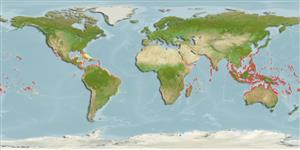Common names from other countries
Environment: milieu / climate zone / depth range / distribution range
Ecologie
marien rifbewoner; standvastig; diepte 1 - 5 m (Ref. 7247). Tropical; 30°N - 30°S
Indo-Pacific: Red Sea and East African coast to the Line and Society Islands, north to the Ryukyu and Bonin Islands, south to New Caledonia and Tonga; throughout Micronesia.
Grootte / Gewicht / Leeftijd
Maturity: Lm ? range ? - ? cm
Max length : 13.0 cm SL mannelijk / geslacht onbekend; (Ref. 7247)
Dorsale stekels (totaal) : 12; Dorsale zachte stralen (totaal) : 14 - 16; Anale stekels: 2; Anale zachte stralen: 12 - 14.
A territorial species commonly found in coral reef areas with dead staghorn corals. Adults feed on filamentous algae supported by these dead corals. Frequently charge human intruders without hesitation, sometimes taking painful nips which are mildly alarming when unexpected. Particularly aggressive during reproductive periods. They emit a clicking noise during aggressive encounters. Act aggressively toward most herbivorous fishes and some other fishes; defend its territory for feeding advantages (Ref. 47011). Oviparous, distinct pairing during breeding (Ref. 205). Eggs are demersal and adhere to the substrate (Ref. 205). Males guard and aerate the eggs (Ref. 205).
Levenscyclus en paargedrag
Maturities | Voortplanting | Spawnings | Egg(s) | Fecundities | Larven
Oviparous, distinct pairing during breeding (Ref. 205). Eggs are demersal and adhere to the substrate (Ref. 205). Males guard and aerate the eggs (Ref. 205).
Allen, G.R. and A.R. Emery, 1985. A review of the Pomacentrid fishes of the genus Stegastes from the Indo-Pacific, with descriptions of two new species. Indo-Pac. Fish. (3):31. (Ref. 510)
Status op de Rode Lijst van het IUCN (Ref. 130435)
CITES (Ref. 128078)
Not Evaluated
Gebruik door de mens
Visserij: van minder commercieel belang
Tools
Speciale rapporten
Download XML
Internetbronnen
Estimates based on models
Preferred temperature (Ref.
115969): 25.5 - 29.3, mean 28.2 (based on 3835 cells).
Fylogenetische diversiteitsindex (Ref.
82804): PD
50 = 0.5000 [Uniqueness, from 0.5 = low to 2.0 = high].
Bayesian length-weight: a=0.02291 (0.01388 - 0.03781), b=2.97 (2.83 - 3.11), in cm Total Length, based on LWR estimates for this species & Genus-body shape (Ref.
93245).
Trofisch niveau (Ref.
69278): 2.0 ±0.0 se; based on diet studies.
Weerstandsvermogen (Ref.
120179): Hoog, minimale populatieverdubbelingstijd minder dan 15 maanden (Preliminary K or Fecundity.).
Fishing Vulnerability (Ref.
59153): Low vulnerability (10 of 100).
